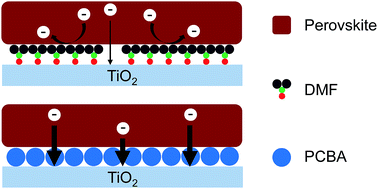Effects of interfacial chemical states on the performance of perovskite solar cells†
Abstract
We showed that the widely used solvent molecule, N,N-dimethyl-formamide (DMF), readily adsorbs on the surface of TiO2 electrodes of perovskite solar cells (PSCs), and that the adsorbed DMF molecules remain intact on the TiO2 surface even after long-term annealing of the perovskite layer, resulting in an increase in the contact resistance of the PSCs. We found that the absorption of DMF is significantly suppressed by modifying the TiO2 electrode surface with a fullerene derivative, [6,6]-phenyl-C61-butyric acid (PCBA). We also suggested that the high electron affinity of PCBA enhances the charge transportation at the perovskite/TiO2 interface and reduces the contact resistance.


 Please wait while we load your content...
Please wait while we load your content...